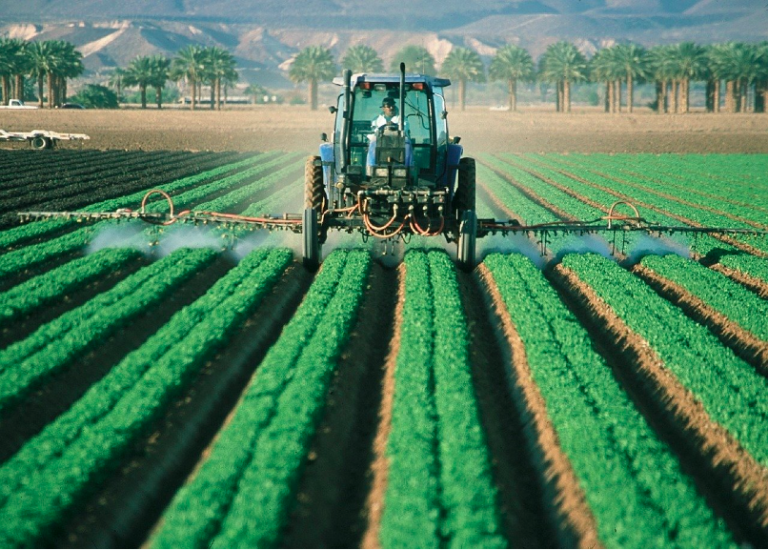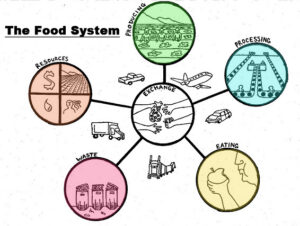How our food is produced and what types of foods we consume can have significant impacts on our environment. Nurses can play a key role in reducing these impacts through their own choices, patient and community education, and involvement in the food choices available at health institutions or facilities. Listed below are some of the challenges with our current food systems that are impacting health, including antibiotic resistance, farmworker exposures, industrial farming, pesticide overuse, and access to fresh fruits and vegetables, as well as some of the solutions such as promoting plant-based diets and sustainable food systems within healthcare and beyond.
ANHE also has a Food and Agriculture Committee working on these very issues. To learn more about the Committee and get involved please visit the Food and Agriculture Committee page.
Food Systems Impact on Public and Environmental Health
While food is essential for health, the way our food is produced places strain on natural resources such as land and water. Attempting to balance feeding a larger population, while ensuring minimal environmental impacts will be a pressing issue facing the sustainability of our food systems. In addition, due the abundance of processed and fast foods, our diets tend to consist of low nutrient and calorie-dense contact foods that increase risk for diet related illnesses, such as obesity, heart disease, and diabetes.
Read the Institute of Medicine’s report: Sustainable Diets: Food for Healthy People and a Healthy Planet: Workshop Summary for a discussion on how food production impacts public and environmental health.
Visit the Food and Agriculture Organizations of the United Nations’ website to learn more about how food sustainability is being addressed globally to ensure food security and access to healthy foods.
Read the blog “The Roots of America’s Broken Food System” and the communities sowing seeds for a healthier future.Interview with Michael Moss, bestselling author of “Salt, Sugar, Fat: How the Food Giants Hooked Us”
Industrial Farm Animal Production
Farming practices over the last century have shifted from small family owned farms to large-scale industrial farms housing large amounts of animals in often confined and unhygienic conditions. Large-scale industrial farms and Concentrated Animal Feeding Operations (CAFOs) have become a mainstay in the agricultural industry as the demand for mass produced meats has increased. Industrial farming poses risks to public and environmental health, along with concern for animal welfare, worker safety, and safety of the food supply.
For further information on this topic, visit the PEW Commission’s report on industrial farm animal production.
Read the Environmental Working Group’s report on meat production and how choices impact climate, environmental, and health.
Antibiotic Use in Food Producing Animals
It is estimated that 70% of medically-important antibiotics sold in the United States are used in food producing animals. The addition of medically-important antibiotics has become common practice to offset crowded and unhygienic conditions often encountered in industrial farming. Antibiotics are added at routine and low doses to animal feeds for the purpose of preventing disease and promoting growth. Since doses are given at subtherapeutic levels, an ideal environment for the proliferation of antibiotic resistant bacteria is created. Resistant bacteria can then spread to humans through contamination of food supply, farm worker exposure, and environmental contamination of land, air, and water further exacerbating the global crisis of antibiotic resistance. For further information, read our page on antibiotic resistance and the chapter in ANHE’s etextbook on Antibiotic Use in Agriculture.
Visit CDC’s website for more information on how antibiotic resistance can spread to humans from food producing animals.
Visit the Natural Resources for Defense Council’s website for more information on misuse of antibiotics in agriculture and what can be done to combat this issue.
Read Food and Water Watch’s report “Antibiotic Resistance 101: How Antibiotic Misuse on Factory Farms Can Make You Sick”.
Pesticide Use in Agriculture and Impacts
Pesticides are commonly used in agriculture to minimize pests to improve crop yields and agriculture productivity. However, there are long term environmental impacts that result from the overuse of these chemicals. Pesticides have been shown to be carcinogenic and to cause problems with our nervous system, endocrine system and lungs when inhaled. Pesticides can infiltrate our groundwater supply polluting our water, contaminating our food, and creating increased risk of exposure for farm workers. In addition, the use of neonicotinoids, a commonly used insecticide in agriculture, has been linked to a phenomenon called colony collapse disorder and subsequent decline in bee populations. This is concerning as bees are necessary for pollination of crops and for a thriving food supply.
Visit EPA’s website for further information on pesticide use in agriculture and ways to maintain safety for public and environmental health.
Review ANHE’s E-textbook Environmental Health in Nursing for more information on how pesticide use in farming, commercially, and homes can impact health.
Visit EPA’s website for information on how pesticide use is impacting bee populations and for an overview of colony collapse disorder.
Farmworker Justice
Our food system is dependent on the use of farmworker’s to ensure an adequate food supply, however farmworkers face many health and environmental justice concerns as a result of working conditions and lack of protections.

Threats to health include working in strenuous conditions, exposure to excessive heat, lack of employment protections, exposure to pesticides and other toxic chemicals, and lack of access to health care.
For more information about the challenges facing farm worker’s visit Farmworker Justice’s website to read the latest reports on farmworker safety in agriculture.
Read about the issues facing farmworkers and the proposed changes to policy and regulations to address these concerns in the report “Justice in the Fields”.
Food Access and Insecurity
Access to quality, affordable and nutritious food is critical to promoting health across populations. However, food access remains a significant barrier to healthy eating in the United States today. Food deserts, communities with limited access to healthy and affordable food options, are greatly impacting the health of children and families. Certain populations, such as low-income, communities of color, and urban communities are more at risk for experiencing food insecurity and poor diets due to financial constraints, transportation limitations, and environmental factors, such as limited healthy food options in communities and the overabundance of food outlets offering minimal healthy options. Nurses can help address food insecurity and access through identifying community risk and working to implement interventions such as farmer’s markets that accept SNAP, community gardens, and adding healthy food options to local stores in food desert neighborhoods.
Visit the USDA’s website for the latest information on food insecurity and key statistics in the United States.
Review the Johns Hopkins Center for a Liveable Future’s survey of the scientific literature on food security in United States cities.
To learn more about community interventions to address food insecurity, review information on community gardens and healthy stores initiatives.
Food & Farm Solutions
There are a variety of solutions that nurses can advance to promote healthier and sustainable food systems. These include transitioning to more plant-based 
Learn more about how to reduce greenhouse gas emissions through food and agriculture solutions at Project Drawdown. Take action through Nurses Drawdown.
Learn more about evidence-based food and farm policies from the Union of Concerned Scientists. These include policies such as dietary guidelines, good food purchasing programs, and local and private sector solutions.
50by40 is a coalition of organisations dedicated to cutting the global production and consumption of animal products by 50% by 2040. Learn more about their core principles and how they are working towards a fair, healthy, and compassionate food system.
View Food Tank’s list of 116 organizations that are working to create a more sustainable global food system.
Promoting Food Sustainability in Healthcare
As large purchasers and suppliers of food to patients, staff, and visitors, the choices healthcare facilities make when determining food options to serve can impact market-based change. By choosing to serve sustainable foods, such as meats produced without the routine use of antibiotics, local and if possible organic fruits and vegetables, and food produced in an environmentally friendly manner can both lower the facilities carbon footprint and lead the transition to more sustainable food systems.
Utilize Health Care Without Harm’s website for information on healthy food in healthcare and how the health sector can be a driver of change. Learn more about how U.S. hospitals are changing the food system here.
Read HCWH’s reports “Redefining Protein: Adjusting Diets to Protect Public Health and Conserve Resources” and “Seasonal Foods: A New Menu for Public Health” for information on how healthcare facilities can adjust menus to promote environmental and public health.
Learn more about plant-forward, a style of cooking and eating that emphasizes and celebrates, but is not limited to, plant-based foods and that reflects evidence-based principles of health and sustainability.

